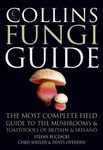Identification Key Monograph
By: JL Rodríguez-Armas(Author), E Beltrán Tejera(Author)
456 pages, 14 plates with b/w photos; 101 b/w line drawings, 1 table
![Contribución al Estudio de los Aphyllophorales (Basidiomycotina) del Monteverde de las Islas Canarias [Contribution to the Study of Aphyllophorales (Basidiomycota) of Monteverde of the Canary Islands] Contribución al Estudio de los Aphyllophorales (Basidiomycotina) del Monteverde de las Islas Canarias [Contribution to the Study of Aphyllophorales (Basidiomycota) of Monteverde of the Canary Islands]]()
Click to have a closer look
About this book
Contents
Customer reviews
Related titles
About this book
Language: Spanish with bilingual summary in English and Spanish
In all, 245 species of Aphyllophorales have been studied; most were collected over the last few years in the course of this investigation. The ecological impact of the lignicolous Aphyllophorales on the forest ecosystems is of prime importance given their leading role in the biodegradation of cellulose and lignin in wood remains. Analysis of the distribution of the Aphyllophorales by vegetable community yields the following findings: of the 268 species catalogued to date for the whole archipelago, 245 grow in the woods where this study was conducted – the monteverde (laurisilva and fayal-brezal) and mixed transition communities of fayal-brezal-pinewood; 231 develop in the monteverde and/or mixed communities with pinewood (L+FB+PM), 129 of them being exclusive to the monteverde; 14 occur in both pinewoods and mixed pinewoods. To date only 18 species have been assigned exclusively to the Canary pinewoods.
With regard to the substrates on which the forest Aphyllophorales evolved, 217 of the 245 species studied (88.57%) proved lignicolous, and 28 terricolous-humicolous (11.42%) These findings confirm the protagonism to be expected of the Aphyllophorales as lignicolous elements and, in consequence, their great importance in maintaining the balance of the forest ecosystems. Keys for the families, genera and species of the known taxa in the Canary Islands are given in the paper. They also include fungi previously ascribed to the Archipelago but which have not been encountered in the forests under investigation.
Contents
1. Introducción 7
2. Concepto y definición del orden Aphyllophorales 8
3. Antecedentes históricos del orden en Canarias 11
4. Metodología 12
5. Área de estudio 16
Vegetación del piso montano húmedo de Canarias 16
6. Síntesis eorológica 20
7. Ecología de los Aphyllophorales forestales 26
8. Catálogo descriptivo 44
Clave de las familias del orden 47
Familia Auriscalpinceae 49
Familia Banheraceae 51
Familia Cantharellaceae 52
Clavarincene y familias afines 53
Familia Clavarinceae 54
Familia Clavulinaceae 66
Familia Gomphaceae 69
Familia Coniophoraceae 75
Familia Corticinceae 82
Familia Fistalinacene 251
Familia Ganodermataceae 253
Familia Hydnaceae 258
Hydnacece residuales 260
Familia Hymenochaetaceae 264
Familia Polyporaceae 284
Familia Schizophyllaceae 344
Familia Stereaceae 347
Familia Thelephoraceae 367
9. Catálogo de distribución insular 381
10. Glosario 391
11. Resumen/Summary 400
12. Bibliografía 407
13. Apéndice fotográfico 421
14. Indice taxonómico 448
Customer Reviews
Identification Key Monograph
By: JL Rodríguez-Armas(Author), E Beltrán Tejera(Author)
456 pages, 14 plates with b/w photos; 101 b/w line drawings, 1 table






![Contribución al Estudio de los Aphyllophorales (Basidiomycotina) del Monteverde de las Islas Canarias [Contribution to the Study of Aphyllophorales (Basidiomycota) of Monteverde of the Canary Islands] Contribución al Estudio de los Aphyllophorales (Basidiomycotina) del Monteverde de las Islas Canarias [Contribution to the Study of Aphyllophorales (Basidiomycota) of Monteverde of the Canary Islands]](http://mediacdn.nhbs.com/jackets/jackets_resizer_xlarge/59/59778.jpg?height=620)
![Contribución al Estudio de los Aphyllophorales (Basidiomycotina) del Monteverde de las Islas Canarias [Contribution to the Study of Aphyllophorales (Basidiomycota) of Monteverde of the Canary Islands]](http://mediacdn.nhbs.com/jackets/jackets_resizer/59/59778.jpg)
![Contribución al Estudio de los Aphyllophorales (Basidiomycotina) del Monteverde de las Islas Canarias [Contribution to the Study of Aphyllophorales (Basidiomycota) of Monteverde of the Canary Islands]](http://mediacdn.nhbs.com/jackets/jackets_resizer/59/59778_1.jpg)
![Contribución al Estudio de los Aphyllophorales (Basidiomycotina) del Monteverde de las Islas Canarias [Contribution to the Study of Aphyllophorales (Basidiomycota) of Monteverde of the Canary Islands]](http://mediacdn.nhbs.com/jackets/jackets_resizer/59/59778_2.jpg)
![Contribución al Estudio de los Aphyllophorales (Basidiomycotina) del Monteverde de las Islas Canarias [Contribution to the Study of Aphyllophorales (Basidiomycota) of Monteverde of the Canary Islands]](http://mediacdn.nhbs.com/jackets/jackets_resizer/59/59778_3.jpg)
![Contribución al Estudio de los Aphyllophorales (Basidiomycotina) del Monteverde de las Islas Canarias [Contribution to the Study of Aphyllophorales (Basidiomycota) of Monteverde of the Canary Islands]](http://mediacdn.nhbs.com/jackets/jackets_resizer/59/59778_4.jpg)




![Die Gattung Hyphodontia John Eriksson [The Genus Hyphodontia John Eriksson]](http://mediacdn.nhbs.com/jackets/jackets_resizer_medium/59/59441.jpg?height=150&width=93)



















![Bibliotheca Diatomologica, Volume 15: Bacillariaceae, Epithemiaceae, Surirellaceae [German]](http://mediacdn.nhbs.com/jackets/jackets_resizer_medium/62/62828.jpg?height=150&width=93)
![Bibliotheca Diatomologica, Volume 38: Insel der Endemiten: Geobotanisches Phänomen Neukaledonien [Island of Endemics: New Caledonia – A Geobotanical Phenomenon]](http://mediacdn.nhbs.com/jackets/jackets_resizer_medium/94/94205.jpg?height=150&width=96)





